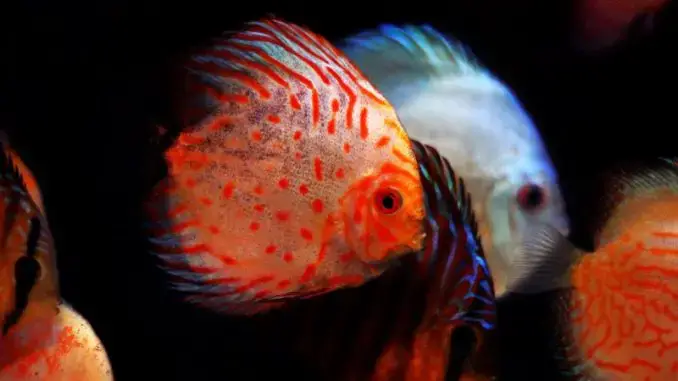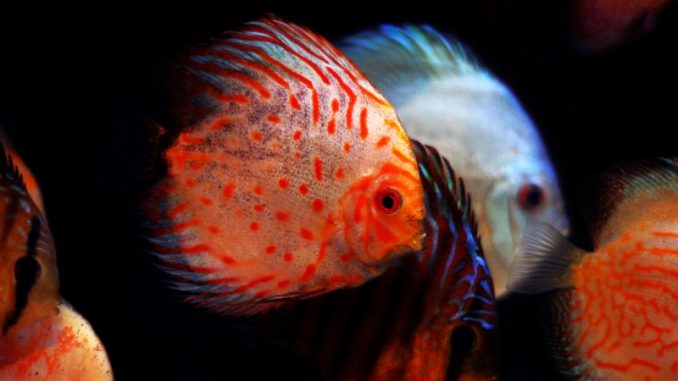
For individuals looking for a unique and vibrant addition to their aquarium, the blood pigeon discus is the ideal choice. This species of fish has some striking features that set it apart from completely different species of discus. Not only is this striking fish found in beautiful shades of pink, purple, yellow and blue, but it also has very specific breeding requirements that must be taken into account when defending it. Additionally, there are certain natural factors associated with these species that require careful monitoring by experienced aquarists. So if you're interested, learn more about what makes the blood pigeon discus so unique. Then learn more as we uncover its fascinating history and delve deeper into general care concepts for this popular pet fish.
Table of contents:
Overview of blood pigeon discus
The Blood Pigeon Discus is a unique and beautiful species of fish that makes an excellent addition to any aquarium. They are native to the Amazon Basin in South America, where they live in slow-moving streams and rivers. Blood pigeon discus fish have a distinctly elongated body structure with pointed fins and bold coloration that ranges from deep red to bright orange, yellow, blue, green and white.
See:
Blood pigeon discus often reach a size of between 6 and 8 inches when fully grown. They have elongated our bodies with pointed fins that give them an elegant look compared to other discus species. Their colors vary from deep red to bright orange, yellow, blue, green and white, making them stand out among the completely different species of freshwater fish.
Behavior:
Pigeon discus fish are peaceful neighborhood fish that prefer to live in groups of at least six or more for optimal health care. In the wild, they form large flocks as protection from predators, but also as social interaction between their own animals. It is therefore important to take this behavior into account when equipping your aquarium accordingly.
Proper water parameters to protect Blood Pigeon Discus include temperatures between 78°F and 86°F (25°C to 30°C). The pH ranges from about 6 to 7, with soft acidic water being the most popular over hard alkaline water. The hardness must be kept low (below 10 dGH). It will probably be important not to overcrowd the aquarium, as these fish need plenty of space to be able to swim freely without feeling too cramped or restricted by their surroundings or their tank mates. Aim for about 20 gallons per person if possible. An excellent filtration system is essential as these fish produce very little waste due to their size. Regular maintenance therefore helps keep the water clear and healthy for everyone living in the aquarium.
The most important thing to take away: Pigeon discus fish are a unique and vibrant species of fish that make an excellent addition to any aquarium. They should be kept in groups of 6 or more, require soft, acidic water with temperatures between 75°F and 85°F, and require at least 20 gallons per individual. For optimal health benefits, an excellent filter system is essential.
Breeding blood pigeon discus
Breeding blood pigeon discus is a rewarding experience for every fish keeper. To check success, it is important to select the right breeding pair and compose the aquarium accordingly.
Choosing a breeding pair:
If you decide to breed a pair of pigeon discus fish, look for healthy specimens with bright colors and good build. Avoid mating two fish that are too similar in size or color, as this can increasingly lead to hybridization. If possible, try to find pairs from completely different bloodlines or parents so that you can get even more offspring.
Preparing the tank for breeding:
Before attempting to breed your discus, make sure the aquarium is properly prepared and has plenty of hiding places and soft water conditions (pH 6-7). The correct temperature fluctuation must be between 28 and 30 °C. Additionally, it is important to maintain low nitrate levels through frequent water changes and the use of a filtration system with a comfortable atmosphere.
Once your discus pairs have mated, they will begin spawning within 24 hours if conditions are right. The female lays her eggs on flat surfaces such as stones or leaves while the male fertilizes them externally before they hatch after two days at 27 °C. After hatching, feed newly hatched brine shrimp every day until they reach 1 inch in size, then transition them to industrial foods such as frozen bloodworms or live black worms twice daily until four months prior to when they are normally relocated , reach maturity in their own personal tank if desired.
Widespread, well-tolerated factors in blood pigeon discus
Pigeon discus fish are a popular freshwater fish species known for their bright colors and peaceful nature. However, like any other pet, they are usually prone to misbehavior if not properly cared for. Understanding the symptoms of illness and stress in your blood pigeon discus is important to providing him with proper care and preventing extreme health problems from occurring.
Indicators of illness and stress:
The most common sign that your blood pigeon discus is also sick or under pressure is a change in its habits. If you notice that your fish are swimming slower than normal or hiding from other fish, this could be compensating for an underlying disadvantage. Other signs include loss of appetite, discoloration on the fins or body, cloudy eyes, bulging eyes, red streaks on the body, or white patches on the skin (which could be covering parasites).
Prevention and remedial strategies:
To prevent disease in your blood pigeon discus fish, it is important to maintain good water quality by regularly testing parameters corresponding to pH ranges and nitrate/nitrite ranges. Additionally, frequent tank maintenance including cleaning filters must be performed to ensure optimal conditions for your fish. When it comes to treating illnesses, it is best to seek the advice of a veterinarian who specializes in aquarium fish before attempting any treatments yourself, as certain medications can have negative effects on these delicate animals if used improperly.
To maintain a healthy blood pigeon discus, a proper nutrition plan is crucial; They need high-quality foods that are specifically tailored to their needs and contain all plant parts (e.g. seaweed waffles) as well as essential foods (e.g. brine shrimp). Feeding an excessive amount at once can lead to overfeeding, which can trigger digestive problems. Therefore, it is best to feed only what is eaten within 5 minutes twice a day, rather than one large meal per day.
The most important thing to take away: Key Takeaway: To keep blood pigeon discus healthy, ensure good water quality, establish a proper plan to reduce the weight of plant material and live food, and seek veterinary advice if illnesses occur.
Diploma
However, they require special care as they have special breeding requirements and are also susceptible to certain health factors. With the right information and dedication, the blood pigeon discus could potentially be a worthwhile pet for any fish keeper or fan.
Are you looking for an attention-grabbing and rewarding ornamental fish? Look no further than the blood pigeon discus! This particular species of tropical freshwater fish is beautiful to look at and relatively easy to handle. They are hardy, peaceful animals that bring life and shade to any aquarium. With the right analysis, tools, maintenance and a little persistence, they will be a good addition to your home or office tank. Let Fish farming world Help you get started on this great journey with our comprehensive guides full of concepts and ideas from experts in the field!

